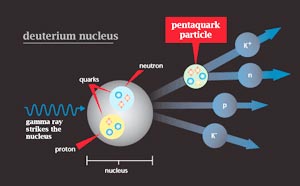Higher Precision Analysis Doesn’t Yield Pentaquark

Researchers sent photons into deuterium nuclei to try to produce pentaquarks. If pentaquarks had been produced, sensitive detectors would have measured a particular mix of Kaons (K-mesons) and protons; neutrons could have been inferred from the data. The researchers did not detect this reaction. Image credit: JLab
New, higher precision data that could only have been gathered at the Department of Energy’s Thomas Jefferson National Accelerator Facility (Jefferson Lab) shows the Theta-plus pentaquark doesn’t appear in another place it was expected. This intriguing finding contradicts evidence previously presented by Jefferson Lab researchers that they had sighted a pentaquark, a particle built of five quarks. Volker Burkert, a Jefferson Lab Experimental Hall Leader, will present this preliminary result in a talk reviewing world pentaquark data at Lepton-Photon, the XXII International Symposium on Lepton-Photon Interactions at High Energy, in Uppsala, Sweden, on Friday, July 1.
The result comes from a very carefully crafted experiment that was designed to repeat Jefferson Lab’s original pentaquark search with a factor of ten higher statistics. Researchers in Jefferson Lab’s CEBAF Large Acceptance Spectrometer (CLAS) collaboration took data with a high-energy photon beam on a deuterium target March 13 – May 16, 2004. Deuterium is an isotope of hydrogen with one proton and one neutron in its nucleus. An earlier probe of this same region by CLAS revealed a possible signal for a pentaquark with mass 1542 MeV.
The new experiment searched for pentaquarks in this same channel at a level of precision at least 10 times higher, or one order of magnitude better, than the previous published result and found no pentaquarks. “The earlier results on the Theta-plus can not be reproduced in the analysis of the high-statistics run,” Burkert says.
Faced with this result, the collaboration re-analyzed the data from the original experiment, taking into account a new understanding of the background obtained from the recent run and improved statistical analysis software. The re-analysis revealed a much weaker signal for the pentaquark in the original experiment.
“One of the problems with the first pentaquark finding is that we didn’t completely understand the background,” Burkert says, “The statistical significance stated in the earlier result is likely due to a combination of statistical fluctuation with an underestimate of the background. We eliminated that problem with the second, higher-statistics run and a more rigorous analysis.”
The first pentaquark sighting was announced by SPring-8 researchers in the spring of 2003, and the same year, Jefferson Lab, ITEP and ELSA researchers announced that they, too, may have spotted tantalizing hints of the particle in data previously taken in other experiments. Several experiments since then have backed up these early sightings, while others have failed to confirm them. Jefferson Lab researchers are currently in the midst of several dedicated hunts for the pentaquark.
Most ordinary matter is built of quarks. They’re usually found in twos (as particles called mesons) and threes (as particles called baryons, such as protons and neutrons). While the pentaquark’s five-quark configuration is not forbidden by the theory of the strong interaction, finding one would be the first sighting of an exotic baryon.
For more information, or to schedule an interview, contact:
Kandice Carter, kcarter@jlab.org or ph. (757) 269-7263
or Linda Ware, ware@jlab.org or ph. (757) 269-7689
Thomas Jefferson National Accelerator Facility’s (Jefferson Lab’s) basic mission is to provide forefront scientific facilities, opportunities and leadership essential for discovering the fundamental structure of nuclear matter; to partner in industry to apply its advanced technology; and to serve the nation and its communities through education and public outreach. Jefferson Lab, located at 12000 Jefferson Avenue, is a Department of Energy Office of Science research facility managed by the Southeastern Universities Research Association.
Media Contact
More Information:
http://ww.jlab.orgAll latest news from the category: Physics and Astronomy
This area deals with the fundamental laws and building blocks of nature and how they interact, the properties and the behavior of matter, and research into space and time and their structures.
innovations-report provides in-depth reports and articles on subjects such as astrophysics, laser technologies, nuclear, quantum, particle and solid-state physics, nanotechnologies, planetary research and findings (Mars, Venus) and developments related to the Hubble Telescope.
Newest articles

How marine worms regenerate lost body parts
The return of cells to a stem cell-like state as the key to regeneration. Many living organisms are able to regenerate damaged or lost tissue, but why some are particularly…

Nano-scale molecular detective
New on-chip device uses exotic light rays in 2D material to detect molecules. Researchers have developed a highly sensitive detector for identifying molecules via their infrared vibrational “fingerprint”. Published in Nature…

Novel CAR T-cell therapy
… demonstrates efficacy and safety in preclinical models of HER2-positive solid tumors. The p95HER2 protein is found expressed in one third of HER2+ tumors, which represent 4% of all tumors….



